Are you tired of your voice sounding thin and muffled on calls or recordings? It might be time to ditch that tinny built-in laptop microphone and level up your audio game. A quality desk microphone can be the secret weapon that transforms you from “kind of hard to hear” to “crystal clear and professional.”
Understanding the Basis
- Polar Patterns: These dictate how a microphone captures sound. ‘Cardioid’ focuses on your voice in front while minimizing background noise. ‘Omnidirectional’ picks up equally from all directions, and ‘Bidirectional’ is great for interviews with two people.
- Connection Type: USB microphones are plug-and-play, while XLR models require an audio interface but offer more potential for upgrades.
- Features: Look for gain controls (adjusting mic sensitivity), mute buttons, and headphone jacks for real-time monitoring.
Factors to Consider
- Your Budget: Great mics exist at every price point. Set a sensible budget before you start browsing.
- Primary Use: Is it just for podcasts, or do you also want to record music? This influences your choices.
- Desk Space: A huge mic might not be practical on a cramped desk. Check the dimensions before you buy.
- Aesthetics: Do you want sleek and subtle or a mic that makes a statement (hello, RGB lighting)?
Reviews Of The Best Desk Microphones
Here is a detailed review of the top desk microphones. Let’s take a closer look.
Shure MV7
The Shure MV7 is a dynamic microphone directly inspired by the legendary Shure SM7B. It stands out by offering the classic broadcast sound quality of the SM7B while adding modern versatility with its hybrid USB and XLR connections.
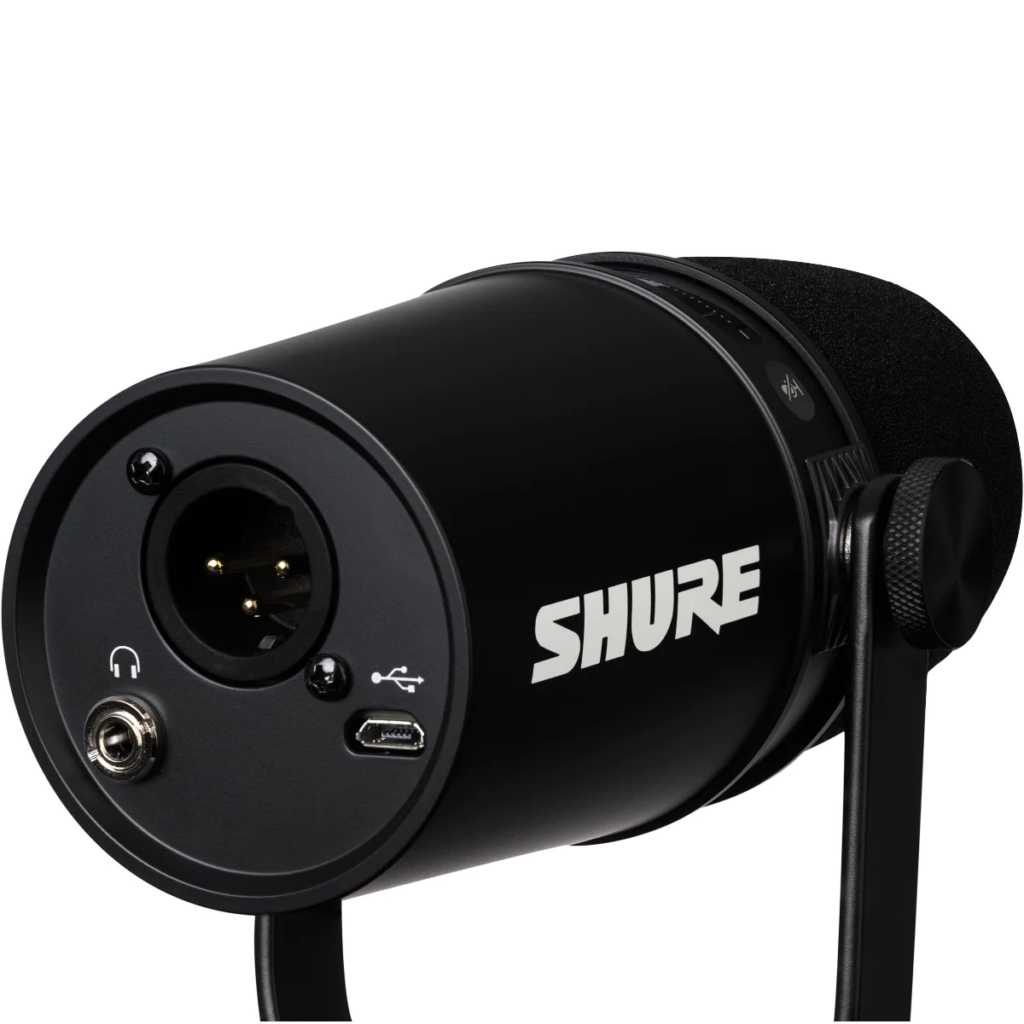
Price range: $250 to $260
Type: Hybrid XLR/USB Microphone
Polar pattern: Cardioid
Sound Quality
The MV7 boasts a rich, warm, and remarkably clear sound. Its cardioid pattern focuses beautifully on your voice while expertly minimizing unwanted background noise. This sound quality rivals far more expensive XLR-only microphones, making it a favorite for everything from podcasting to vocal recordings.
Build Quality & Design
Shure’s reputation for top-notch build quality shines through in the MV7. Its all-metal construction feels rock-solid, and the sleek design with an integrated yoke mount exudes a professional aesthetic.
Features:
- Easily connects to computers via USB for plug-and-play simplicity.
- Conveniently adjust microphone gain, headphone volume, and monitor mix with touch controls.
- It also offers an auto-level mode for users who prefer a hands-off approach.
- Monitor yourself in real-time with no distracting delay.
Pros:
- Superb audio quality with the classic Shure broadcast sound.
- Hybrid connections offer versatility unmatched by USB-only or XLR-only mics.
- Excellent noise rejection for clean recordings in imperfect environments.
- Rugged build quality.
- Intuitive touch controls and helpful software.
Cons:
- Can be a bit pricey for those needing just a simple USB mic.
- The touch panel may be too sensitive for some.
- Shure’s app provides customization, but more advanced users might find it a bit limited.
Who is it for?
- Podcasters: The sound quality and background noise rejection elevate your podcast to a professional level.
- Content Creators: You’ll sound great on voiceovers, streams, or video calls.
- Musicians: Can easily record vocals without needing additional gear (audio interface), though some may still prefer a traditional condenser mic.
Razer Seiren Mini
Razer’s Seiren Mini packs a surprising punch for its tiny size and budget-friendly price. This compact USB condenser mic aims to bring fuss-free, decent-quality sound to streamers, podcasters, and anyone wanting an upgrade to their built-in laptop microphone.

Price range: $35 to $40
Type: USB Microphone
Polar pattern: Supercardioid
Sound Quality
Don’t expect professional broadcast quality, but the Seiren Mini’s audio reproduction is surprisingly crisp and clear for its size. Its supercardioid polar pattern does a good job of focusing on your voice and reducing background noise, making it suitable for less-than-ideal recording environments.
Build Quality & Design
The Seiren Mini has a robust build that feels well-made for the price. Its pill-shaped design is minimal and comes in various colors (black, white, pink) to suit your setup. The fixed base with a built-in tilt mechanism keeps things simple while providing some angle adjustments.
Features:
- Tightly focused on your voice, reducing background noise pickup
- No drivers or software required – just plug it in and start recording
- Offers some basic protection against bumps and vibrations
Pros:
- Super affordable, making it an easy upgrade from basic computer mics.
- Very compact and portable, great for small desks.
- Decent sound quality that easily outperforms most built-in laptop mics.
- Simple to use, no confusing settings or software.
Cons:
- No mute button, gain control, or headphone jack.
- The supercardioid pattern can be very focused, so you need to be close to the mic.
- Fixed stand lacks the flexibility of boom arms or adjustable stands.
Who is it for?
- Budget-Conscious Beginners: Perfect if you’re just starting in content creation and want something basic, affordable, and easy to use.
- Students and Remote Workers: A clear upgrade for better audio quality during video calls and classes.
- Gamers Wanting an Upgrade: If you just want to improve your voice chat quality in games without breaking the bank.
Blue Yeti USB
The Blue Yeti is a USB condenser microphone that’s consistently been one of the most popular choices for podcasters, streamers, and YouTubers. It’s known for its user-friendliness, multiple polar patterns, and reputation for good sound quality.
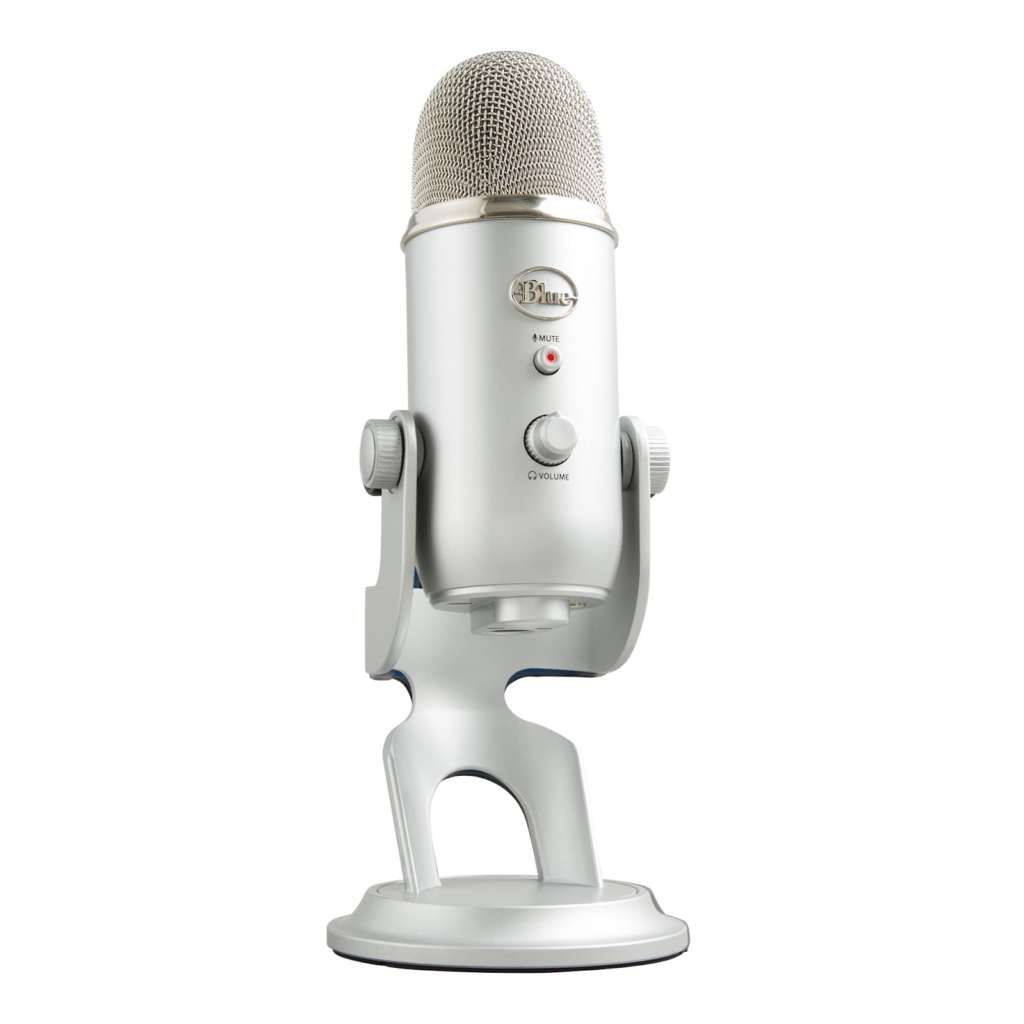
Price range: $80 to $90
Type: USB Microphone
Polar patterns: Cardioid, Omnidirectional, Bidirectional, Stereo
Sound Quality
With three internal capsules, the Yeti delivers clear, rich audio that’s a noticeable step up from built-in computer mics. It’s sensitive, so it captures vocal nuances but may also pick up more room noise if your environment isn’t perfectly quiet.
Build Quality & Design
The Blue Yeti has a unique, retro-inspired look and sturdy metal construction. However, its large size and hefty stand mean it needs ample desk space.
Features:
- A physical knob to adjust how sensitive the mic is.
- Convenient for quickly silencing the mic.
- Monitor yourself in real-time with zero latency.
Pros:
- Easy plug-and-play setup with no drivers needed.
- Versatile polar patterns for different recording situations (solo podcast, interviews, etc.).
- Good sound quality that’s a significant improvement over basic built-in mics.
- Onboard controls are useful and intuitive.
Cons:
- Can be quite large and bulky for some setups.
- Its sensitivity makes it prone to picking up background noise.
- Some users report issues with the sturdiness of the stand over time.
- More expensive than some newer USB mics that offer comparable sound quality.
Who is it for?
- Beginners: The ease of use and versatility make it very beginner-friendly.
- Content creators needing flexibility: The multiple polar patterns cater to various recording situations.
- Anyone wanting a recognized “standard” for good USB audio: The Yeti has a long-standing reputation.
Audio-Technica AT2020USB+
The Audio-Technica AT2020USB+ builds on the success of its XLR counterpart (the AT2020), a favorite in studios for its clear, detailed sound. The USB+ delivers that same excellent sound quality in a simple, plug-and-play USB format ideal for home recording.
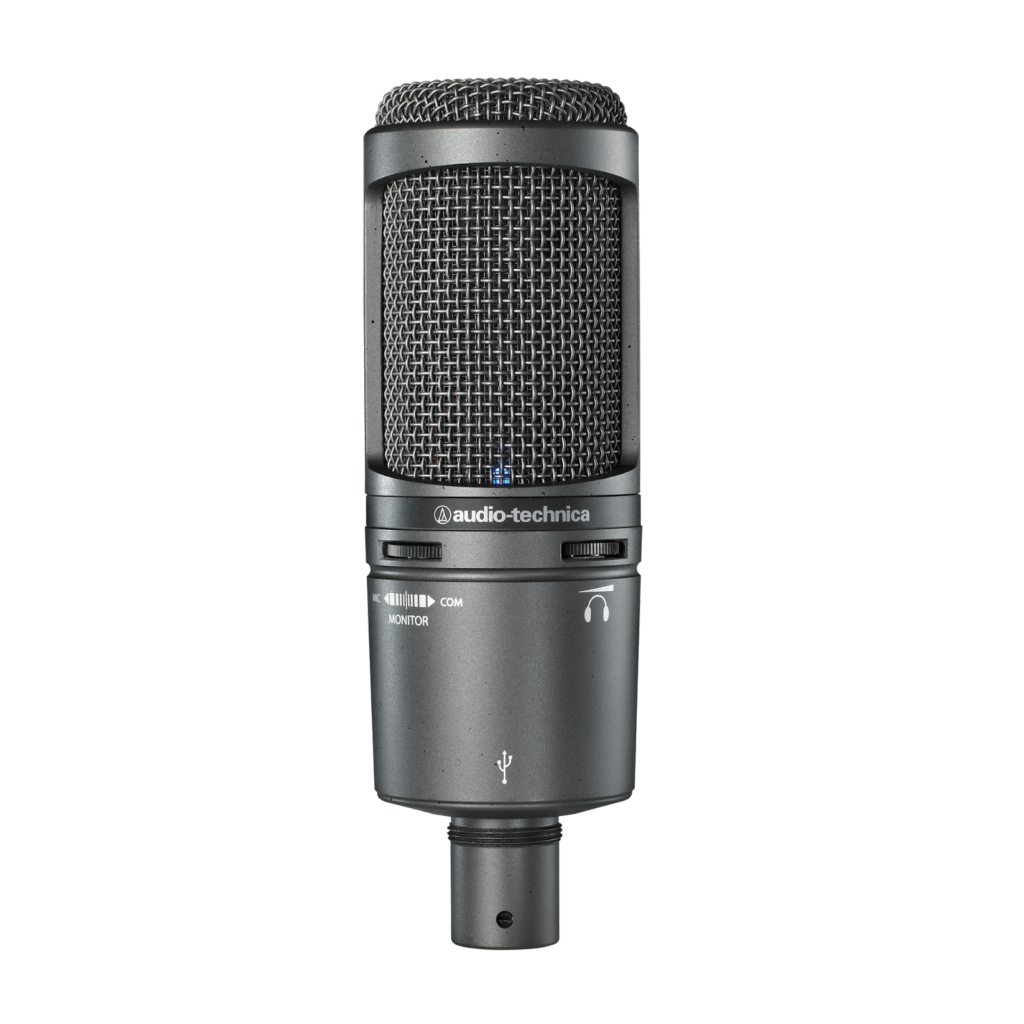
Price range: $150 to $160
Type: USB Microphone
Polar pattern: Cardioid
Sound Quality
This mic shines with its exceptional audio quality for the price. Its cardioid pattern captures vocals and instruments with fantastic clarity, warmth, and natural detail. Background noise rejection is good, especially if you’re mindful of mic placement.
Build Quality & Design
It inherits the sturdy, all-metal build from its XLR sibling. While the design is understated, it feels robust and built to last. The included desktop tripod stand isn’t the best, but it gets the job done for basic setups.
Features:
- Focuses on sound directly in front, minimizing unwanted noise
- Easy plug-and-play, compatible with Mac and Windows computers
- Monitor your audio in real-time with zero distracting delay
- Blend between your microphone signal and pre-recorded audio, useful for podcasters or layering tracks
Pros:
- Studio-quality sound at a reasonable price point.
- Excellent for capturing vocals and acoustic instruments.
- Durable construction and a reliable brand name.
- Built-in features like headphone monitoring and mix control enhance usability.
Cons:
- Included tripod stand can be a bit flimsy.
- Some users may desire additional features like a physical gain control and mute button.
- Prone to picking up keyboard noise if you type loudly while recording.
Who is it for?
- Podcasters: Delivers clear, professional-sounding voice recordings.
- Musicians: Great for capturing vocals and acoustic instruments for demos or home studios.
- Voiceover Artists: Provides the clarity and quality needed for professional-sounding recordings.
- Anyone wanting a significant upgrade without XLR complexity: Ideal if superb audio quality is your priority but you don’t want to deal with audio interfaces.
HyperX Quadcast S
The HyperX QuadCast S is a USB condenser microphone that immediately captures attention with its eye-catching RGB lighting and sleek design. It builds upon the original QuadCast’s strong foundation, adding customizable RGB and a focus on gamer and streamer aesthetics.

Price range: $150 – $160
Type: USB Microphone
Polar patterns: Cardioid, Omnidirectional, Bidirectional, Stereo
Sound Quality
The QuadCast S delivers clear, balanced audio thanks to its three internal condenser capsules. Its cardioid polar pattern does a good job of reducing unwanted background noise, but be mindful of positioning. The sound may not be quite as studio-neutral as some competitors, but the overall quality is great for voice-focused applications.
Build Quality & Design
The mix of metal and plastic construction feels quite sturdy. Its standout feature is the customizable RGB lighting that adds a dynamic touch to your gaming setup. The integrated shock mount helps reduce vibrations and bumps, a plus for those with less-than-stable desks.
Features:
- Cardioid, stereo, omnidirectional, and bidirectional for flexibility in different recording situations.
- Conveniently located at the top of the mic for quickly silencing audio.
- A physical knob for easy adjustments to microphone sensitivity.
- Monitor your recordings with zero latency.
- Customize RGB lighting effects and save settings.
Pros
- Eye-catching RGB design that stands out on camera.
- Good audio quality well-suited for streaming, podcasts, and voice work.
- Easy-to-use controls and software for customization.
- Tap-to-mute sensor adds convenience.
- Included shock mount helps minimize accidental noises.
Cons
- Some users report a slight background hiss.
- The RGB lighting might not be for everyone’s style.
- Software customization can feel a little basic compared to some competitors.
Who is it for?
- Streamers and content creators: The RGB lighting, clear audio, and tap-to-mute are all geared towards live content creation.
- Gamers who want better mic quality: A solid upgrade if you want to sound clear on voice chats and add some flair to your setup.
- Podcasters and voiceover artists: Multiple pattern options and clear audio lend well to these applications.
Elgato Wave:3
The Elgato Wave:3 is a USB condenser microphone focused on providing excellent sound quality while prioritizing streaming and content creation convenience. Its key strength lies in its integration with Elgato’s software ecosystem and its focus on preventing audio clipping.
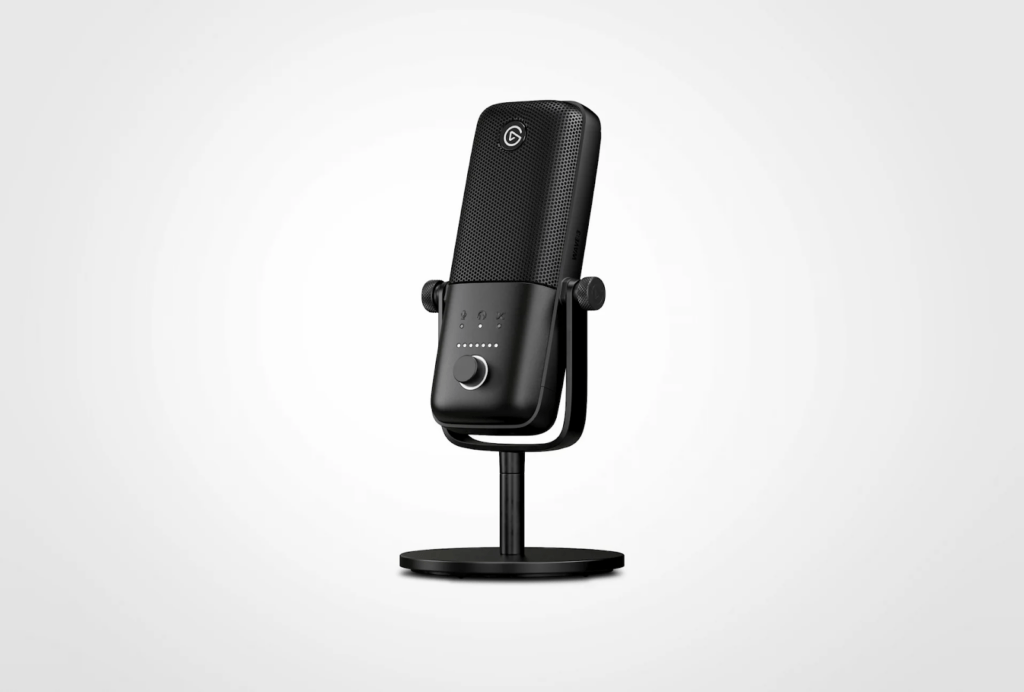
Price range: $180 to $190
Type: USB Microphone
Polar pattern: Cardioid
Sound Quality
You’ll enjoy crisp, clear audio ideal for broadcasting your voice. The cardioid polar pattern helps focus on what’s presently in front of it, minimizing unwanted background noises. While it might not have the most nuanced studio-level sound, it’s great for streaming, voiceovers, and podcasts.
Build Quality & Design
The Wave:3 features a sleek, no-nonsense design. The build quality feels solid thanks to the predominantly metal construction. Its compact size is a plus if your desk space is limited.
Features:
- Tight focus for clearer voice capture, reducing background noise pickup
- It actively monitors audio and dynamically adjusts levels to prevent distortion and peaking
- Mix audio from multiple sources, create submixes, and offers some effects processing
- Lightly touch the top to mute your microphone
- Adjust gain, headphone volumes, and crossfade between mic and PC sound
Pros
- Clipguard technology is excellent for those who often struggle with audio levels peaking.
- Wave Link software integration is helpful for detailed audio control, especially for streamers.
- Clean audio quality well-suited for voice recordings.
- Compact design saves desk space.
Cons
- Can be on the pricier side for its feature set.
- Relies heavily on software for full functionality.
- Might lack advanced features for users needing fine-grained control over their sound.
Who is it for?
- Streamers: The Clipguard and Wave Link software integration make it a compelling choice for live broadcasts.
- Less experienced content creators: If you worry about audio distortion or complex settings, the Wave:3 simplifies things.
- Users within the Elgato ecosystem: Benefits most if you already use Elgato’s Stream Deck or other products.
Hollyland LARK M2
The Hollyland LARK M2 is a compact, premium wireless microphone system created for content creators, vloggers, filmmakers, and anyone who needs high-fidelity audio recording on the go. This user-friendly system offers excellent sound quality, ease of use, and impressive features.
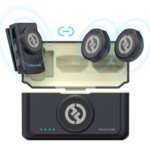
2-Person Wireless Mini Button Microphone.

Price range: $150 to $250
Type: Button Microphone
Polar pattern: Omnidirectional
Sound Quality
The LARK M2 boasts a 48 kHz/24-bit sampling rate, offering excellent audio resolution and depth for its size. Features built-in noise cancellation technology to minimize background distractions for cleaner voice recordings.
Build Quality & Design
Transmitters are incredibly small and lightweight (only 9g!), making them comfortable and unobtrusive for wearing on clothing. The casing feels well-made and able to withstand everyday use.
Features:
- Intuitive plug-and-play design
- Multiple charging options
- Versatile for use with a wide range of cameras
Pros
- Great audio quality for its compact size
- Lightweight and comfortable for long-term use
- Excellent wireless range
- Long battery life (transmitter and charging case)
- Versatility for various recording scenarios
Cons
- Can be slightly more expensive than direct competitors
- May pick up interference in areas with lots of wireless traffic
- The absence of a dedicated headphone jack on the receiver means limited options for monitoring audio on-site
Who is it for?
The Hollyland LARK M2 is ideal for:
- Vloggers & Content Creators: A hassle-free solution for solo video creators who value portability and ease of use.
- Interviewers/Podcasters: Great for recording multiple people due to the dual-transmitter versions.
- Mobile Journalists: Compact and reliable for on-the-go recordings
- Filmmakers: Can be a handy solution for backup audio or discrete mic placement when larger boom setups aren’t practical.
FAQs
Why should I invest in a desk microphone?
Built-in computer and headset mics are often subpar. A dedicated desk microphone vastly improves audio quality for podcasts, streaming, online calls, and recordings of any kind.
What’s the difference between USB and XLR microphones?
USB mics offer simple plug-and-play convenience. XLR mics require an audio interface but offer more potential for customization and upgrades down the line.
What are the most important features to look for?
Think about whether you need a specific polar pattern (cardioid is standard), gain control for adjusting sensitivity, a mute button, and a headphone jack for monitoring your audio.
What’s the best microphone for my specific use (podcasting, gaming, music recording, etc.)?
Different use cases might favor certain features. For example, podcasts often need focused cardioid mics while musicians might benefit from more detailed studio-style microphones.
What is a polar pattern?
It describes the area from which the microphone picks up sound. Common patterns include cardioid (front focused), omnidirectional (captures all around), and bidirectional (front and back).
Ready to Upgrade?
Investing in a quality desk microphone instantly elevates your content creation and communication. Do your research, consider your needs, and soon you’ll be broadcasting your voice with crystal-clear confidence!































.png)



